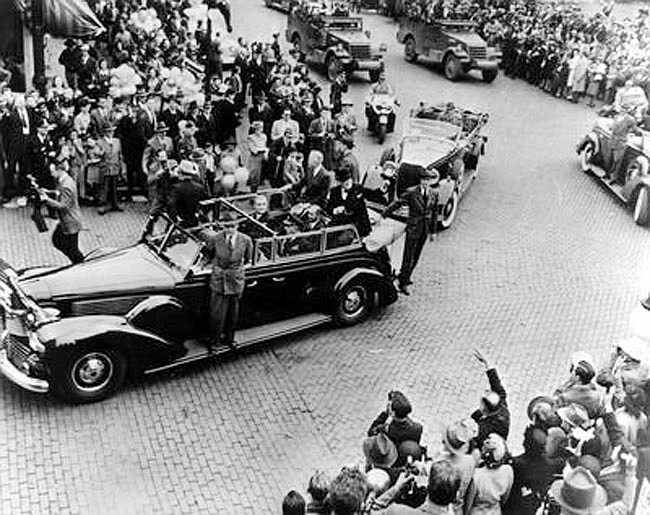When Sir Winston Churchill and U.S. President Harry S. Truman came to Fulton on March 5, 1946, the whole town came out to wave at the motorcade.
Secret Service men clung to the limo's running boards like watchful mountain goats, and crowds dressed in their finest competed with media outlets from around the state, nation and world.
The motorized promenade ended at Westminster College. There, Churchill, former prime minster who led Britain through World War II, reportedly had a drink and maybe a cigar before giving his now famous Iron Curtain speech, "The Sinews of Peace."
Churchill and Truman are gone from the world, but memory of them is not. This May 3-5, officials of the National Churchill Museum, created in memory of that event, are celebrating with the community the museum's 50th anniversary.
Also, at 2:30 p.m. that Saturday, there will be a repeat parade with members of the Churchill and Truman families.
Trying their best to recreate the parade, all the same high school and military bands have been invited back, to include a band of pipers. The parade begins at Westminster Avenue and West Seventh Street, winds through city streets then north on Court Street, to end at the museum.
A reviewing stand will be across the street from the museum. There also will be a flyover and a salute to the Eagle Squadrons of World War II and Lt. John Lutz, of Fulton.
Sam Craghead is executive secretary for the museum's 50th Anniversary Project. He said he feels Lutz's story is worthy of consideration.
Flying eagles
"In 1940, the Germans had just conquered France, and they now controlled Continental Europe," Craghead said recently, sitting on a bench on the front porch of The Churchill Institute. "They are looking at the White Cliffs of Dover from one of their places in France. The threat is they are now going to invade England - and Churchill and England know it."
On May 10, 1940, Churchill had become prime minister of the United Kingdom. By May 26, Allied troops were trapped on the beaches of Dunkirk. Between May 27 and June 4, by use of any sea-worthy vessel they could find, 330,000 troops - French, British, Belgian and Dutch - were slowly and methodically evacuated. Of the 861 vessels in the operation, 243 were sunk. Britain had to regroup, and quickly.
"The British expeditionary force was evacuated from Dunkirk, and that gave them the soldiers they needed badly," Craghead said. "In order to invade Britain, Germany must assault England from across the Channel."
Britain had plenty of military airplanes, but not enough pilots. They gathered together some pilots escaped from Poland, Czechoslovakia, France, Belgium, Holland and Norway, and "the RAF also began receiving Americans," Craghead added.
At that time, the United States was still neutral in what was considered to be a European war.
"If American citizens joined the military of another country at war, they would lose their citizenship," Craghead said.
Enter John Frederick Lutz, a 1936 graduate of Fulton High School. He had one academic year at Westminster College when he left for California where he earned a pilots license.
"He was approached to join the RAF," Craghead said.
RAF is the famous Royal Air Force, the United Kingdom's aerial warfare force formed toward the end of World War I, on April 1, 1918. They emerged as the largest air force in the world.
Lutz traveled to Canada, then England, and became a fighter pilot for the RAF's 71st Eagle Squadron (First Squadron) in September 1941. He was 23.
"He fought with the RAF until September 1942, then he and other Eagles transferred to the U.S. 8th Army Air Force," said Craghead. "All Eagles were Americans. They are still called Eagles today."
On May 4, 1943 - the date of this year's parade - Lutz died.
"John was with a group of U.S. Air Force planes escorting a bomb run over German-occupied Europe when he had engine trouble and headed back to Europe," Craghead said. "He bailed out over the Channel and his chute failed to open. He was MIA/KIA."
Lutz' friend, First Lt. H.D. Hively, sent a letter to Lutz' parents.
"He bailed out at 2,000 feet, but his chute only partially opened and he never got in his dingy. (Another pilot) stayed with him over 15 minutes, but I'm afraid I can offer no hope, for I have none myself."
Lutz wasn't the only pilot lost. One third of the Eagle pilots never came home, and more than 20,000 American airmen died while on active service in Britain.
"In September 1992, surviving members of the RAF Eagle Squadron designated St. Mary the official chapel of the Eagle Squadron," Craghead said. "And May 4 is 1st Lt. John F. Lutz Day by proclamation of the (Fulton) mayor."
The parade will honor the Eagles, some members of which also will be on hand.
"Every one of the musical units (except the pipe band) will be playing Kenneth Alford's Eagle Squadron March," Craghead said. "Alford wrote the music to 'Bridge of the River Kwai.'"
Listen to the song at youtube.com/watch?v=32lL_DO71vE.
Craghead said he thought Lutz's story deserves the light of day.
"I think this is a fantastic story and I think it's one most people don't know," he added.
Particulars
Last Sunday, the Fulton Sun ran a schedule of events for the Churchill Museum anniversary weekend. For the parade, VIP bleachers will be erected at the corner of Westminster Avenue and West Seventh Street. Organizer Tyler Oberlag said there will be porta-potties dotted throughout the area, and four food vendors on hand.
"The museum will have free admission all weekend," he added.

